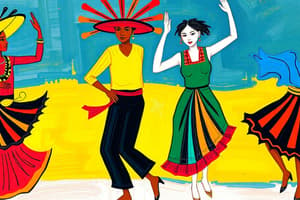Podcast
Questions and Answers
What does 'Brush' mean in Philippine folk dances?
What does 'Brush' mean in Philippine folk dances?
Weight on one foot, hit the floor with the ball or heel of the other foot after which that foot is lifted from the floor to any direction.
What is the direction of movement described by 'Clockwise'?
What is the direction of movement described by 'Clockwise'?
Like the motion of the hands of a clock, moving toward the left when facing the center.
What is 'Counterclockwise' movement?
What is 'Counterclockwise' movement?
The reverse direction of clockwise, with the left shoulder toward the center and movement toward the right.
What does 'Cut' mean in the context of Philippine folk dances?
What does 'Cut' mean in the context of Philippine folk dances?
Define 'Draw' in Philippine folk dances.
Define 'Draw' in Philippine folk dances.
What is referred to as the 'Free Foot'?
What is referred to as the 'Free Foot'?
What is the meaning of 'Stamp' in dance terminology?
What is the meaning of 'Stamp' in dance terminology?
What does the term 'Set' refer to in Philippine folk dance?
What does the term 'Set' refer to in Philippine folk dance?
What is the action described by 'Tap'?
What is the action described by 'Tap'?
What does 'Whirl' mean in dance terms?
What does 'Whirl' mean in dance terms?
Flashcards are hidden until you start studying
Study Notes
Dance Terms Used in Philippine Folk Dances
- Brush: Execute a movement by placing weight on one foot and striking the floor with the ball or heel of the opposite foot, followed by lifting the struck foot in any direction.
- Clockwise: Movement mimics the hands of a clock; the right shoulder turns toward the center of an imaginary circle, moving left when facing the center.
- Counterclockwise: Opposite of clockwise; the left shoulder faces the center of an imaginary circle, moving right when facing inward.
- Cut: Quickly displace one foot with the other, lifting the weight from the first foot entirely.
- Draw: Pull one foot along the floor to close proximity with the other foot, with weight possibly shifting.
- Free Foot: The foot not currently supporting the body's weight.
- Free Hand: The hand not engaged in any action or holding position.
- Inside Foot: The foot closest to one's partner when standing side by side.
- Inside Hand: The hand nearest to one's partner during side-by-side positions.
- Outside Foot: The foot positioned away from one's partner in a side-by-side stance.
- Place: Position the foot firmly at a designated spot while bearing weight, ensuring the sole rests on the floor.
- Pivot: Perform a turn around a fixed point using the ball, heel, or entire foot.
- Set: A specific dance formation, often forming a square or unit, consisting of two or more pairs.
- Stamp: Forcefully bring the foot down onto the floor, producing noise, with or without shifting weight.
- Step: Move by raising or shifting one foot to another location, resulting in a complete weight transfer.
- Supporting Foot: The foot that carries the body's weight during movements.
- Tap: Lightly touch the floor with the free foot while maintaining weight on the opposite foot, without any transfer of weight.
- Whirl: Execute rapid turns by making small steps in place to the right or left.
Dance Steps and Arm Positions in Philippine Folk Dance
- No specific details provided on steps and arm positions to summarize.
Studying That Suits You
Use AI to generate personalized quizzes and flashcards to suit your learning preferences.




